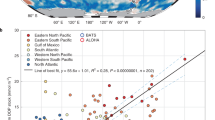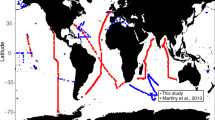Abstract
During glacial periods, low atmospheric carbon dioxide concentration has been associated with increased oceanic carbon uptake, particularly in the southern oceans. The mechanism involved remains unclear. Because ocean productivity is strongly influenced by nutrient levels, palaeo-oceanographic proxies have been applied to investigate nutrient utilization in surface water across glacial transitions. Here we show that present-day cadmium and phosphorus concentrations in the global oceans can be explained by a chemical fractionation during particle formation, whereby uptake of cadmium occurs in preference to uptake of phosphorus. This allows the reconstruction of past surface water phosphate concentrations from the cadmium/calcium ratio of planktonic foraminifera. Results from the Last Glacial Maximum show similar phosphate utilization in the subantarctic to that of today, but much smaller utilization in the polar Southern Ocean, in a model that is consistent with the expansion of glacial sea ice and which can reconcile all proxy records of polar nutrient utilization. By restricting communication between the ocean and atmosphere, sea ice expansion also provides a mechanism for reduced CO2 release by the Southern Ocean and lower glacial atmospheric CO2.
This is a preview of subscription content, access via your institution
Access options
Subscribe to this journal
Receive 51 print issues and online access
$199.00 per year
only $3.90 per issue
Buy this article
- Purchase on Springer Link
- Instant access to full article PDF
Prices may be subject to local taxes which are calculated during checkout






Similar content being viewed by others
References
Toggweiler, J. R. & Sarmiento, J. in The Carbon Cycle and Atmospheric CO2: Natural Variations Archaean to Present Geophys. Monogr. Ser. Vol. 32 (eds Sundquist,E. T. & Broecker,W. S.) 163–184 (AGU, Washington DC, 1985).
Mortlock, R. A. et al. Evidence for lower productivity in the Antarctic Ocean during the last glaciation. Nature 351, 220– 223 (1991).
Rosenthal, Y., Dahan, M. & Shemesh, A. Southern Ocean contributions to glacial–interglacial changes of atmospheric pCO2: an assessment of carbon isotope records in diatoms. Paleoceanography 15, 65– 75 (2000).
De La Rocha, C. L., Brzezinski, M. A., DeNiro, M. J. & Shemesh, A. Silicon-isotope composition of diatoms as an indicator of past oceanic change. Nature 395, 680–683 (1998).
Sigman, D., Altabet, M. A., Francois, R., McCorkle, D. C. & Gaillard, J.-F. The isotopic composition of diatom-bound nitrogen in Southern Ocean sediments. Paleoceanography 14, 118–134 ( 1999).
Francois, R. et al. Contribution of Southern Ocean surface-water stratification to low atmospheric CO2 concentrations during the last glacial period. Nature 389, 929–935 (1997).
Kumar, N. et al. Increased biological productivity and export production in the glacial Southern Ocean. Nature 378, 675– 680 (1995).
Anderson, R. F. et al. Late Quaternary changes in productivity of the Southern Ocean. J. Mar. Syst. 17, 497– 514 (1998).
Kohfeld, K. E., Anderson, R. F. & Lynch-Stieglitz, J. Carbon isotopic disequilibrium in polar planktonic foraminifera and its impact on modern and last glacial maximum reconstructions. Paleoceanography 15, 53 –64 (2000).
Murnane, R. J. & Stallard, R. F. Germanium/silicon fractionation during biogenic opal formation. Paleoceanography 3, 461–471 ( 1988).
Bareille, G., Labracherie, M., Mortlock, R. A., Maier-Reimer, E. & Froelich, P. N. A test of (Ge/Si)opal as a palaeorecorder of (Ge/Si)seawater. Geology 26, 179–182 (1998).
Francois, R., Bacon, M. P., Altabet, M. A. & Labeyrie, L. D. Glacial/interglacial changes in sediment rain rate in the SW Indian sector of Subantarctic waters as recorded by 230Th, 231Pa, U, and δ15N. Paleoceanography 8, 611–629 (1993).
Shemesh, A., Macko, S. A., Charles, C. D. & Rau, G. H. Isotopic evidence for reduced productivity in the glacial Southern Ocean. Science 262, 407–410 (1993).
Boyle, E. A. Cadmium: Chemical tracer of deepwater paleoceanography. Paleoceanography 3, 471–489 ( 1988).
Rickaby, R. E. M. & Elderfield, H. Planktonic foraminiferal Cd/Ca: Paleonutrients or paleotemperature. Paleoceanography 14, 293–303 ( 1999).
de Baar, H. J. W., Saager, P. M., Nolting, R. F. & van der Meer, J. Cadmium versus phosphate in the world ocean. Mar. Chem. 46, 261–281 (1994).
Loscher, B. M., van der Meer, J., de Baar, H. J. W., Saager, P. M. & de Jong, J. T. M. The global Cd/P relationship in deep ocean waters and the need for accuracy. Mar. Chem. 59, 87–93 ( 1997).
Yeats, P. A. An isopycnal analysis of cadmium distributions in the Atlantic Ocean. Mar. Chem. 61, 15–23 ( 1998).
Saager, P. M. On the relationship between trace metals and nutrients in sea water. Thesis, Free Univ. (1994).
Rutgers van der Loeff, M., Helmers, E. & Kattner, G. Continuous transects of cadmium, copper and aluminium in surface waters of the Atlantic Ocean, 50° N to 50° S: Correspondence and contrast with nutrient-like behaviour. Geochim. Cosmochim. Acta 50, 47–61 (1997).
Boyle, E. A., Huested, S. S. & Jones, S. P. On the distribution of copper, nickel and cadmium in the surface waters of the North Atlantic and North Pacific Ocean. J. Geophys. Res. 86, 8048–8066 (1981).
Sherrell, R. M. The trace metal geochemistry of suspended oceanic particulate matter. Thesis, MIT (1989).
Rickaby, R. E. M. Planktonic foraminiferal Cd/Ca: a new perspective on South Ocean palaeoproductivity. Thesis, Cambridge Univ. (1999).
Saager, P. M., de Baar, H. J. W. & Howland, R. J. Cd, Zn, Ni and Cu in the Indian Ocean. Deep-Sea Res. 39, 9–35 ( 1992).
Frew, R. D. & Hunter, K. A. Cadmium-phosphorus cycling at the subtropical convergence south of New Zealand. Mar. Chem. 51, 223–237 (1995).
Bruland, K. W., Knauer, G. A. & Martin, J. A. Cadmium in north east Pacific waters. Limnol. Oceanogr. 23, 618–625 (1980).
Abe, K. & Matsunaga, K. Mechanism controlling Cd and PO 4 concentrations in Funka Bay, Japan. Mar. Chem. 23, 145–152 (1988).
Price, N. M. & Morel, F. M. M. Cadmium and cobalt substitution for zinc in a marine diatom. Nature 344, 658–660 (1990).
Cullen, J. T., Lane, T. W., Morel, F. M. M. & Sherrell, R. M. Modulation of cadmium utilization by phytoplankton by seawater concentration. Nature 402, 165–167.
Boyle, E. A. The role of vertical chemical fractionation in controlling Late Quaternary atmospheric carbon dioxide. J. Geophys. Res. 93, 15701–15714 (1988).
Keigwin, L. D. & Boyle, E. A. Late Quaternary paleochemistry of high-latitude surface waters. Paleogeogr. Paleoclimatol. Paleoecol. 73, 85–106 ( 1989).
Rosenthal, Y., Boyle, E. A. & Labeyrie, L. Last glacial maximum paleochemistry and deepwater circulation in the Southern Ocean: Evidence from foraminiferal cadmium. Paleoceanography 12, 787–797 ( 1997).
Pichon, J.-J. et al. Surface water temperature changes in the high latitudes of the Southern hemisphere over the last glacial-interglacial cycle. Paleoceanography 7, 289–318 (1992).
Luz, B. Late Pleistocene paleoclimates of the South Pacific based on statistical analysis of planktonic foraminifera. Paleogeogr. Paleoclimatol. Paleoecol. 22, 61–78 ( 1977).
Zielinski, U., Gersonde, R., Sieger, R. & Utterer, D. Quaternary surface water temperature estimations: Calibration of a diatom transfer function for the Southern Ocean. Paleoceanography 13, 365–383 (1998).
Jouzel, J. et al. Extending the Vostok ice-core record of paleoclimate to the penultimate glacial period. Nature 364, 411–416 (1993).
Boyle, E. A. Oceanic chemical distributions during the stage 2 glacial maximum: Cadmium and δ13C evidence compared. Annu. Rev. Earth Planet. Sci. 20, 245–287 (1992).
Broecker, W. S. & Henderson, G. M. The sequence of events surrounding Termination II and their implications for the cause of glacial-interglacial CO2 changes. Paleoceanography 13, 352–364 ( 1998).
Ganeshram, R. S., Pedersen, T. F., Calvert, S. E. & Murray, J. W. Large changes in oceanic nutrient inventories from glacial-interglacial periods. Nature 376, 755–757 (1995).
Rau, G. H., Sullivan, C. W. & Gordon, L. I. δ13C and δ15N variations in Weddell Sea particulate organic matter. Mar. Chem. 35, 355–369 ( 1991).
Hutchins, D. A. & Bruland, K. W. Iron-limited diatom growth and Si:N uptake ratios in a coastal upwelling regime. Nature 393, 561–564 ( 1998).
Takeda, S. Influence of iron availability on nutrient consumption ratio of diatoms in oceanic waters. Nature 393, 774– 777 (1998).
Falkowski, P. G. Evolution of the nitrogen cycle and its influence on the biological pump in the ocean. Nature 342, 637– 642 (1997).
Arrigo, K. R. et al. Phytoplankton community structure and the drawdown of nutrients and CO2 in the Southern Ocean. Science 283 , 365–367 (1999).
Crosta, X., Pichon, J.-J. & Burckle, L. H. Application of modern analog technique to marine Antarctic diatoms: Reconstruction of maximum sea-ice extent at the Last Glacial Maximum. Paleoceanography 13, 284– 297 (1998).
Levitus, S., Burgett, R. & Boyer, T. World Ocean Atlas 1994 Vol. 3 Nutrients (Natl Oceanic Atmos. Admin. Atlas Natl Environ. Satellite Data Inf. Serf. 3, US Dept of Comm., Washington DC, 1994).
Broecker, W. S. An oceanographic explanation for the apparent carbon isotope-cadmium discordancy in the glacial Antarctic. Paleoceanography 8, 137–139 (1993).
Stephens, B. & Keeling, R. F. The influence of Antarctic sea ice on glacial-interglacial CO2 variations. Eos 80, F79 (1999).
Toggweiler, J. R. Variation of atmospheric CO2 by ventilation of the ocean's deepest water. Paleoceanography 14, 571– 588 (1999).
Martin, J. H., Fitzwater, S. E, Gordon, R. M., Hunter, C. N. & Tanner, S. J. Iron, primary production and carbon-nitrogen flux studies during the JGOFS North Atlantic Bloom Experiment. Deep-Sea Res. 40, 115–134 (1993).
Acknowledgements
We thank Y. Rosenthal, R. Sherrell and J. Cullen for preprints of their work and N. Shackleton for helpful discussions. This work was supported by NERC.
Author information
Authors and Affiliations
Corresponding author
Rights and permissions
About this article
Cite this article
Elderfield, H., Rickaby, R. Oceanic Cd/P ratio and nutrient utilization in the glacial Southern Ocean . Nature 405, 305–310 (2000). https://doi.org/10.1038/35012507
Received:
Accepted:
Issue Date:
DOI: https://doi.org/10.1038/35012507
This article is cited by
-
Millennial and centennial CO2 release from the Southern Ocean during the last deglaciation
Nature Geoscience (2022)
-
Deep Atlantic Ocean carbon storage and the rise of 100,000-year glacial cycles
Nature Geoscience (2019)
-
Varied contribution of the Southern Ocean to deglacial atmospheric CO2 rise
Nature Geoscience (2019)
-
More efficient North Atlantic carbon pump during the Last Glacial Maximum
Nature Communications (2019)
-
The B/Ca and Cd/Ca of a subsurface-dwelling foraminifera Pulleniatina obliquiloculata in the tropical Indo-Pacific Ocean: implications for the subsurface carbonate chemistry estimation
Acta Oceanologica Sinica (2019)
Comments
By submitting a comment you agree to abide by our Terms and Community Guidelines. If you find something abusive or that does not comply with our terms or guidelines please flag it as inappropriate.



